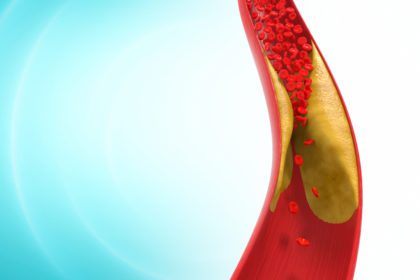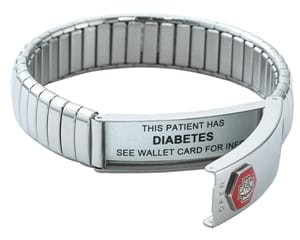Metabolic syndrome, also known as syndrome X or obesity syndrome, is the name of a group of risk factors that increases your risk for:
- Coronary artery disease (CAD) also known as atherosclerotic heart disease – Atherosclerosis is a condition in which plaque (a waxy substance) builds up inside your coronary arteries and hardens and narrows your arteries. The narrowing reduces blood flow to your heart muscle and can result in chest pain, a heart attack, heart damage, or even death.
- Peripheral arterial disease
- Stroke
- Type 2 diabetes
Linked to Overweight, Obesity and Inactivity
 Your risk for heart disease, stroke and diabetes increases with each of the following metabolic risk factors. You have metabolic syndrome if you have THREE OR MORE of these measurements.
Your risk for heart disease, stroke and diabetes increases with each of the following metabolic risk factors. You have metabolic syndrome if you have THREE OR MORE of these measurements.
- Large waistline (abdominal obesity or “having an apple shape”): Greater than 40″ if you’re a man; Greater than 35″ if you’re a woman.
- High triglycerides OR you’re on medication to treat high triglycerides: 150 mg/dL and greater. Triglycerides are a type of fat in your blood.
- Low HDL (“good”) cholesterol level OR you’re on medication to treat low HDL’s: Less than 40 mg/dL (men); less than 50 mg/dL (women). HDL’s or high density lipoproteins help remove cholesterol from your arteries.
- High blood pressure OR you’re on medication to treat high blood pressure: 130/85 mm Hg and higher.
- High fasting blood sugar OR you’re on medication to treat high blood sugar: 100 mg/dL and greater. An early sign of diabetes is a MILDLY high blood sugar, so do take it seriously.
Metabolic syndrome may one day become the leading risk factor for heart disease (more than smoking) due to the rise in obesity amongst adults in the U.S. Compared to someone without metabolic syndrome, a person with metabolic syndrome is:
- Twice as likely to develop heart disease.
- Five times as likely to develop diabetes.
![]() Karen’s Fit Tip: You can prevent (or delay the onset of) metabolic syndrome with lifestyle changes. To reduce your risk factors:
Karen’s Fit Tip: You can prevent (or delay the onset of) metabolic syndrome with lifestyle changes. To reduce your risk factors:
- Lose weight. Follow a high-fiber eating plan. Aim for getting in 40 gm of fiber per day.
- Exercise 5-7 days/week. To lose weight, you’ll need to increase your volume of exercise which may mean 60-90 minutes of moderate-intensity exercise per day.
- Quit smoking.





